Back in the summer of 2018, Cycling Plus magazine visited Slovenia's Julian Alps for a ride in the mountains that had it all – snow-capped peaks, cobbled climbs, glacial lakes and the country's highest road.
Now, with Tadej Pogačar becoming the first Slovenian to win the Tour de France and his compatriot, Primož Roglič, finishing second (a first in itself), we revisit that day in Slovenia's high mountains.
If the Julian Alps weren't on your must-ride list, this might make you reconsider (once we're allowed to travel, of course).
"Eoin, tell me, what are your needs?" enquired Klemen. Sweat pouring down his pained face, and breathing heavy, Eoin’s reply is quick and to the point, if a little beyond Klemen’s capabilities. “A helicopter and a hospital.”
Klemen is Klemen Cepirlo, our driver, mechanic, soigneur and local sage all rolled into one compact Slovenian package.
Eoin is Eoin McCoy, an Irishman living in Poland’s Krakow for the past 18 years and one of several guests of cycling holiday outfit Podia – also based in Krakow – on this trip to Slovenia’s Julian Alps. (Editor's note: Podia has paused its cycling holidays but still sells quality apparel through the company's website)

Eoin’s anguish is understandable. We’re on the fourth and final day of an increasingly mountain-packed trip to the northwestern corner of this central European country and Max Burgess, Podia’s founder, has conspired, Grand Tour-like, to backload the trip with Slovenia’s biggest road challenge – its highest road, the Mangart.
Previous days had seen us explore the mountains and valleys of the Triglav National Park and today, our final ride of the trip, had dialled up the altitude with passage over the Vršič, a 1,611m giant of the region that’s simultaneously both beauty and beast.
If the Vršič Pass had added another 400 vertical metres to any of the previous climbs we’d ridden, the towering Mangart, its head in the clouds of an increasingly brooding late afternoon sky, does likewise, crashing through the 2,000m mark and adding another 72m for good measure.

At the point where Eoin had made his tongue-in-cheek call for aerial assistance we’d been climbing for 15km from Bovec, our base for the week and where we’d passed through again on our way to the Mangart. But the 11.7km up to the Mangart Saddle, as it’s known, had yet to begin. Eoin’s needs – all our needs – would become far greater before they subsided.
The Vršič Pass in numbers
- Length: 10.36km (from Kranjska Gora)
- Height: 1,611m
- Elevation gain: 711m
- Average gradient: 6.9%
- Hairpins: 50
Small and mighty
Small in stature, Slovenia still manages to pack a wallop. That’s particularly true of the Triglav National Park, with its eponymous mountain standing at 2,864m – both Slovenia’s highest peak and that of the whole former Yugoslavia.
Much of Triglav covers the mountainous region known as the Julian Alps, which span northeastern Italy and Slovenia, and named after Julius Caesar.
In professional road cycling terms Slovenia, a country of just two million people, punches well above its weight. The current men’s WorldTour is packed with Slovenians, including Tadej Pogačar (Team UAE–Emirates), Primož Rogli (Team LottoNL–Jumbo) and Matej Mohori (Bahrain-Merida).
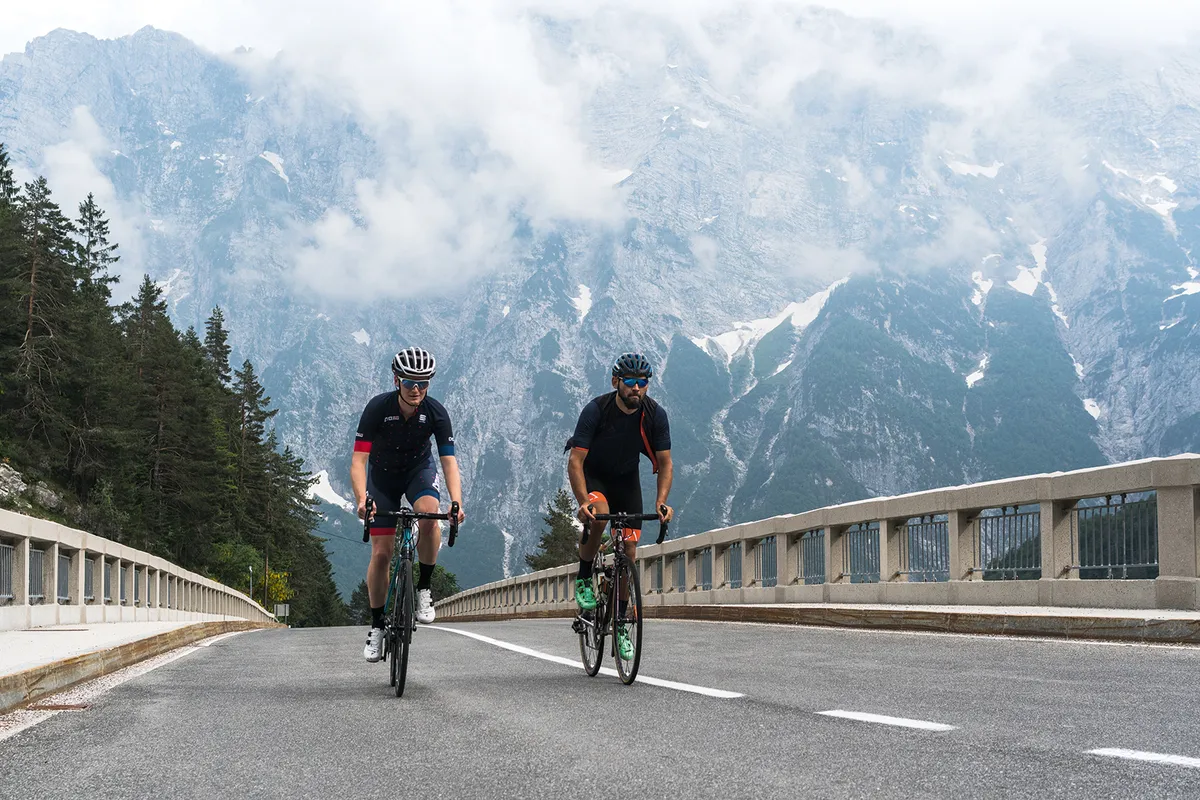
The Julian Alps don’t get as much love as neighbouring Alps in Italy, France and Switzerland when it comes to elite bike racing, even from the Tour of Slovenia.
Though the country’s national race has climbed the Vršič Pass, it’s done so just once (2013) in the past decade, before that, in 2007, a young Vincenzo Nibali took one of the first wins of his career here.
The Mangart remains untapped, though that, says the race’s press officer, is more because of the “logistical nightmare” of taking the race up such a high, isolated, dead-end road. It’s actually their dream to head up there.
What this means is that the region fits nicely into Podia’s ‘Hidden Europe’ message – taking cyclists to the less-heralded but no less magnificent regions of Europe that fly under the radar.

Car share
To see the best of the Julian Alps and not have 160km-plus days to tame, car transfers are a necessary evil, and so it was that our 93km ride began in the van of our ride guide, Maciej Proficz, who as well as being a top road racer also moonlights as the frontman in a death metal band, Dormant Audio.
Our base for the week was the small ski resort town of Bovec, on the western edge of Triglav close to the Italian border, and it would be an hour’s drive to another town, the larger Kranjska Gora, at the base of the Vršič, where our ride would begin.
Despite his musical pedigree, Maciej’s listening tastes are far broader and the journey to the start was accompanied by mass singalongs to the back catalogue of American rock-pop heroes Toto. Maciej belted out Rosanna in particular with gusto.
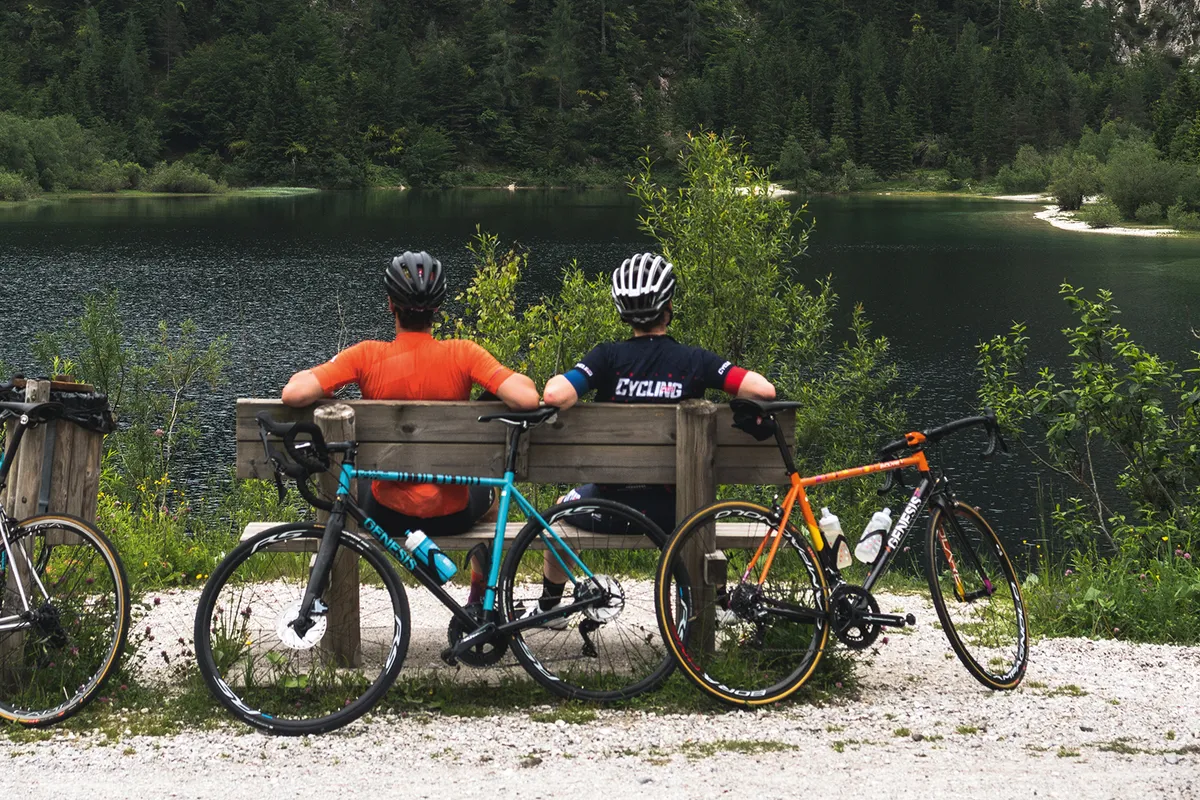
This drive took us up a road that had become familiar. Around 15km from Bovec, we’d descended down it on day two to finish the ride, driven up it on day three to get to the start at Lake Bohinj and were due to end today coming down off the Mangart. Descending it is a blast, full of new tarmac, steep slopes and sinewy bends.
“I can’t wait to come down this again,” exclaimed an excited Michał Tretyn, one of Podia’s paying punters.
“You’re going to have to go up it first,” I offered back.
“Excuse me?”
“You have to go up it. This takes us up to the start of the Mangart, and then we come back down it on the way to the hotel,” I insisted.
If it wasn’t for Toto, I reckon I’d have heard his heart sinking – it’s a stinker of climb.
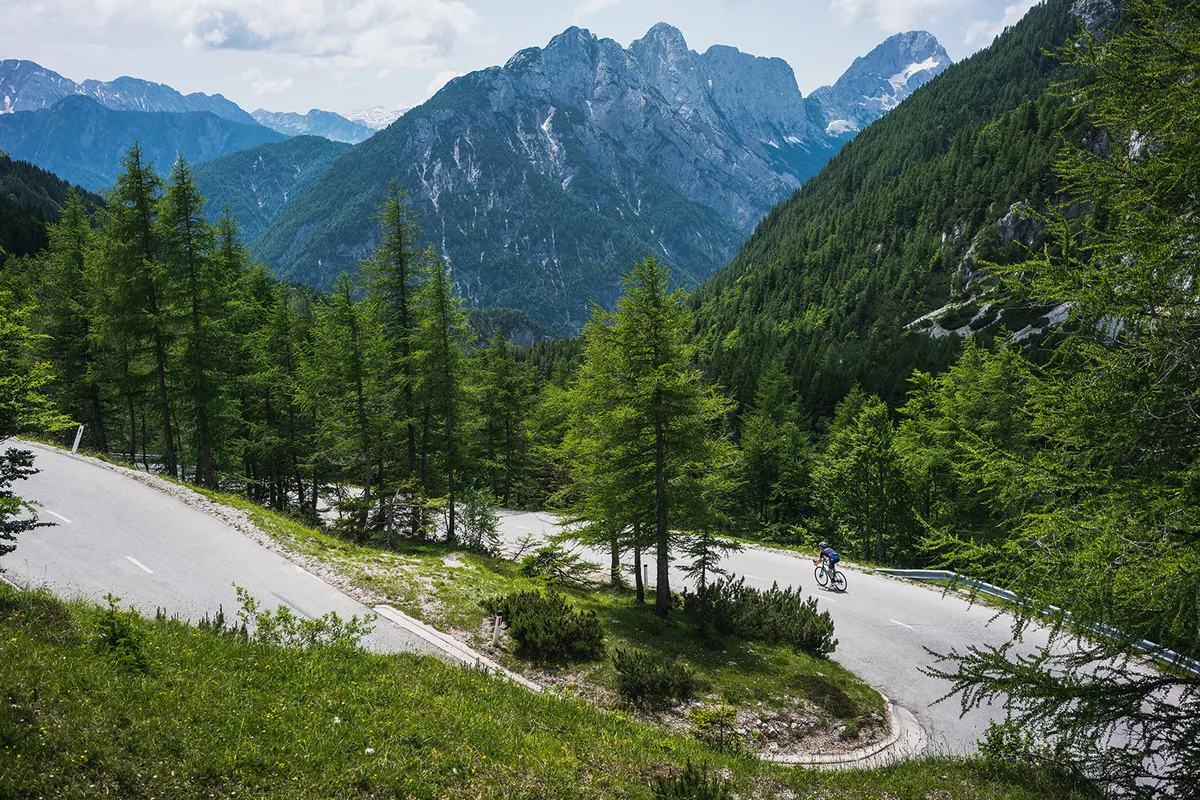
In truth, the Vršič was little easier but where the climb to the Mangart is a long slog up on an unremarkable main road, the Vršič, especially from the Kranjska Gora side, is – and this might sound like a writer overplaying their hand – one of the finest stretches of asphalt to be found anywhere in Europe.
The Vršič Pass from the Kranjska Gora side is one of the finest stretches of asphalt to be found anywhere in Europe
Not that it is all asphalt. Each hairpin on this northern side of the pass remains cobbled and another reason why this is the best side to climb – though each section is small and well-maintained, you don’t want to corner them in the wet.
The Russian Road
As beautiful a sight as the pass is today, it forever carries a tragic history. While a version of the pass had already existed before World War One, the pass we know today is largely thanks to the work of over 10,000 Russian prisoners of war, under the watch of their Austrian captors.
In the spring of 1916, two severe avalanches claimed over 300 Russian lives and several Austrian guards. The chapel at kilometre four on the Kranjska Gora side was built a year later by the prisoners in memory of their fallen comrades and their own suffering.
In 2006, 90 years after its construction, the Slovenian government paid for its restoration and renamed this stretch the Russian Road.
Your suffering will be put firmly in perspective, but it’s only after the chapel that the 9.25km Vršič gets its claws into you, and barring a couple of flat sections it’s largely double digits from there to the 1,611m summit – the highest pass in Slovenia.
If this side is the best to climb, the south, free of cobbles, is surely the best descent, with a largely free run at the 26 hairpins and 12km (8.1 per cent) into Trenta
If this side is the best to climb, the south, free of cobbles, is surely the best descent, with most of the summer tourist traffic seemingly turning back for Kranjska Gora at either the summit or the chapel, allowing us a largely free run at the 26 hairpins and 12km (8.1 per cent) into Trenta.
In all, the Vršič has 50 hairpins, every one of them numbered, Alpe d’Huez-like. But which came first? In his book Mountain Higher, cycling journalist Daniel Friebe tells the story of Georges Rajon, who took the Tour de France to Alpe d’Huez in 1952.
A frequent visitor to Slovenia, he was the owner of the Alpe’s Hotel Christina, now in the hands of his daughter Christiane, who confirmed her father brought the idea home from one of his many Slovenian hunting holidays.
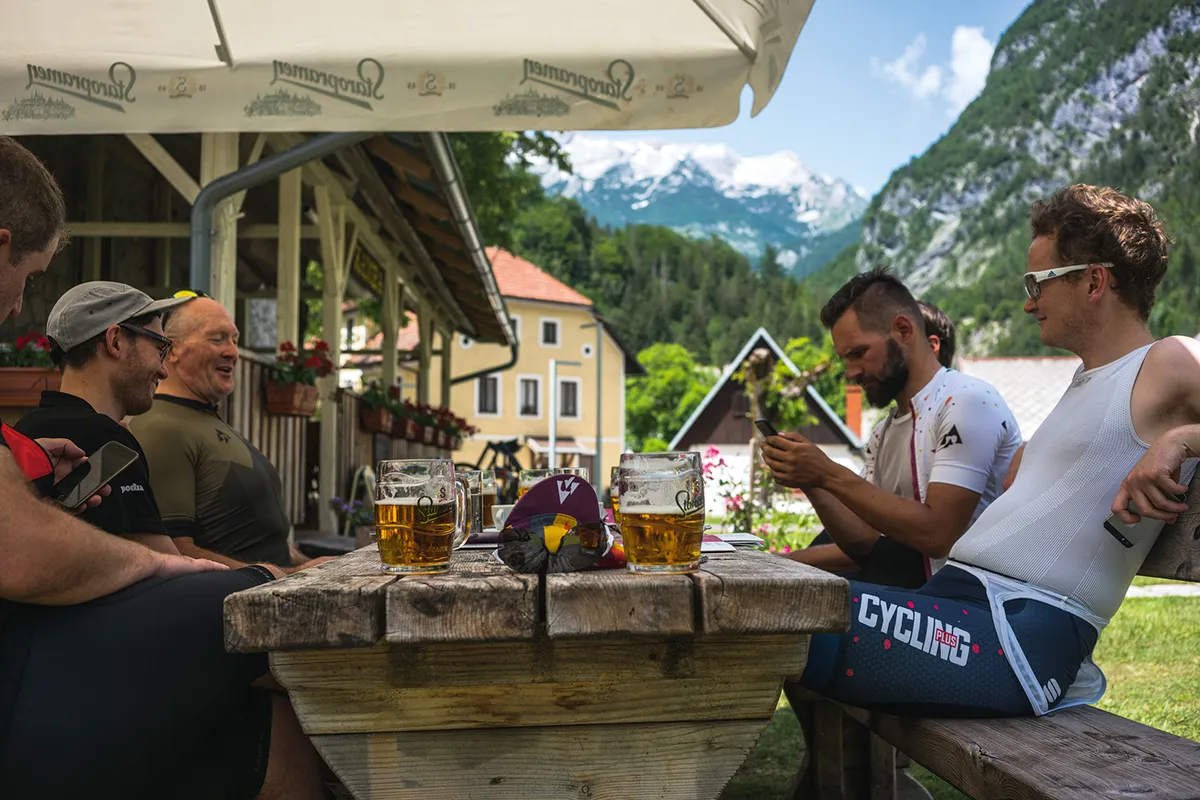
Lunch was taken at the foot of the Vršič in Trenta. In character with the rest of my week with Podia, it was late, long and leisurely, with pizza eaten and beers sunk on the warmest, brightest day of the week.
One rider’s bike computer actually had a beer count metric, showing how many beers he could drink to make up his calorie deficit. It was wise he didn’t take up the computer’s invitation to sink eight lagers, given it had gone 3pm, we’d only covered 24km of 93km and had almost 2,000m still to climb, the bulk of it in one continuous chunk up the Mangart.
Like Vršič, the Mangart is another climb built for war. This time it was the Italian army, constructing it in 1938 over six months as defence against the Yugoslav army
Like Vršič, here’s another climb built for war. This time it was the Italian army, constructing it in 1938 over six months as defence against the Yugoslav army.
The final climb of both the day and the trip is tough, but shorn of this context, the Mangart, climbing 980m in 12km, was objectively the biggest challenge of the trip. Second to its Wikipedia entry on Google is its dangerousroads.org webpage, which hadn’t escaped anybody’s attention.
There’s nothing to be overly concerned about, just a few notes of caution. It’s a dead-end road (the summit – the saddle, a bell-shaped loop – overlooks Italy) so it’s not used that often, which means debris, particularly early in the summer, is often strewn across the road. It’s very narrow and there are several poorly lit tunnels, that make for a weirdly sense-deprived riding experience if you don’t have lights.
The Mangart in numbers
- Length: 10.18km
- Height: 2,072m
- Elevation gain: 947m
- Average gradient: 8.8%
- Tunnels: 5
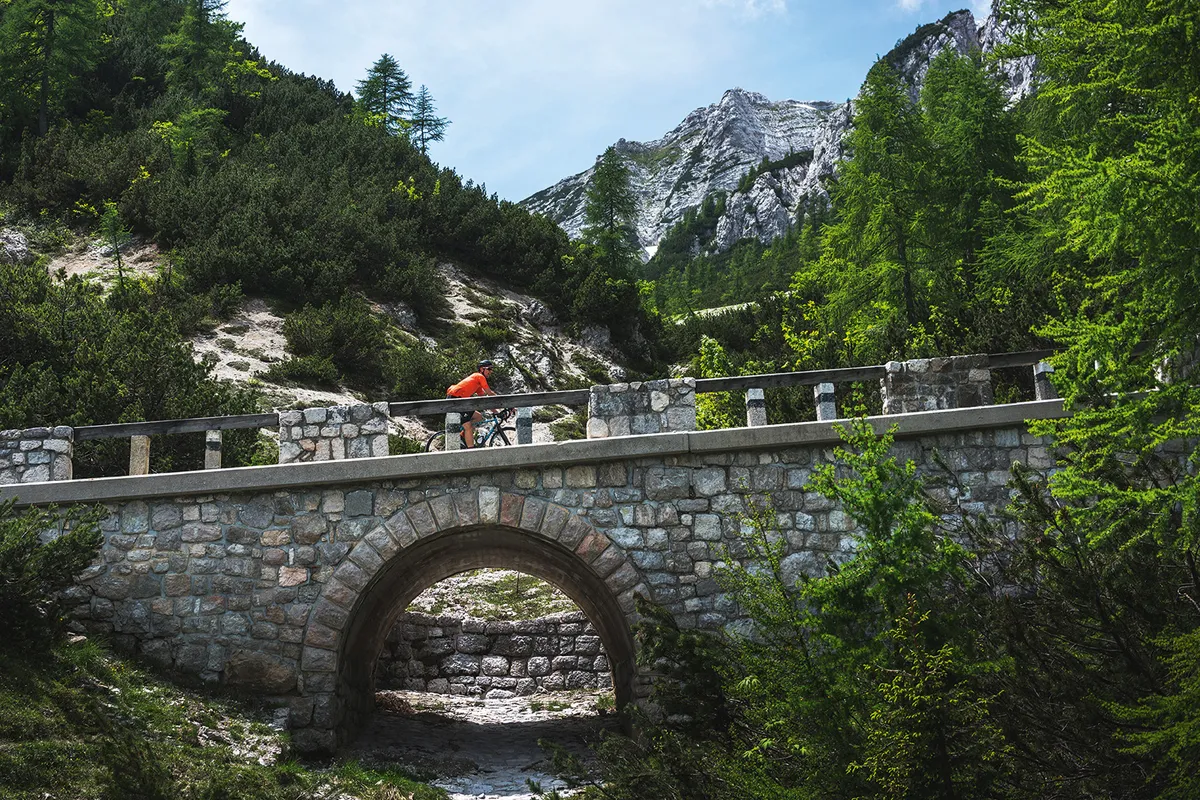
Our long charge to the summit was abruptly cut short just before it. Given the Mangart isn’t a pass, local authorities weren’t in a hurry to clear the winter snowfall. Just as we were about to corner one of the final bends, a head-height blockade of snow stopped us in our tracks.
Reluctantly turning around, we were left to look back down this spectacular mountain from the highest road in the country (well, almost!). The poor weather promised at the start of the day had stayed away, but now, close to 7pm, it was belatedly closing in, and fast.
But we’d already got what we’d come for – a spectacular ride in one of Europe’s best-kept secrets. The hard work was done and all that remained was the long descent back to our Bovec base. Our needs? Every one of them, well and truly satisfied.
Local knowledge
- Distance: 57 miles/93km
- Grade: Difficult (what it lacks in distance it makes up for in altitude gain)
- Download: Komoot
Getting there
We flew to Venice Marco Polo airport and from there it’s a two-and-a-half hour drive to Bovec. Alternatively, you could fly into Slovenia’s capital Ljubljana, though you’d be faced with a similar car transfer to Bovec.
Where to stay
We stayed at the Hotel Sanje OB Soči (sanjeobsoci.com), on the outskirts of Bovec. Facilities include a spa and breakfast, but it doesn’t offer lunch or dinner.
Food and drink
Bovec has many options for food and drink, though the best place we ate was just up the road in the village of Log pod Mangartom, at the Mangrt restaurant, on the right-hand side as you head north through it. The burger is highly recommended.
